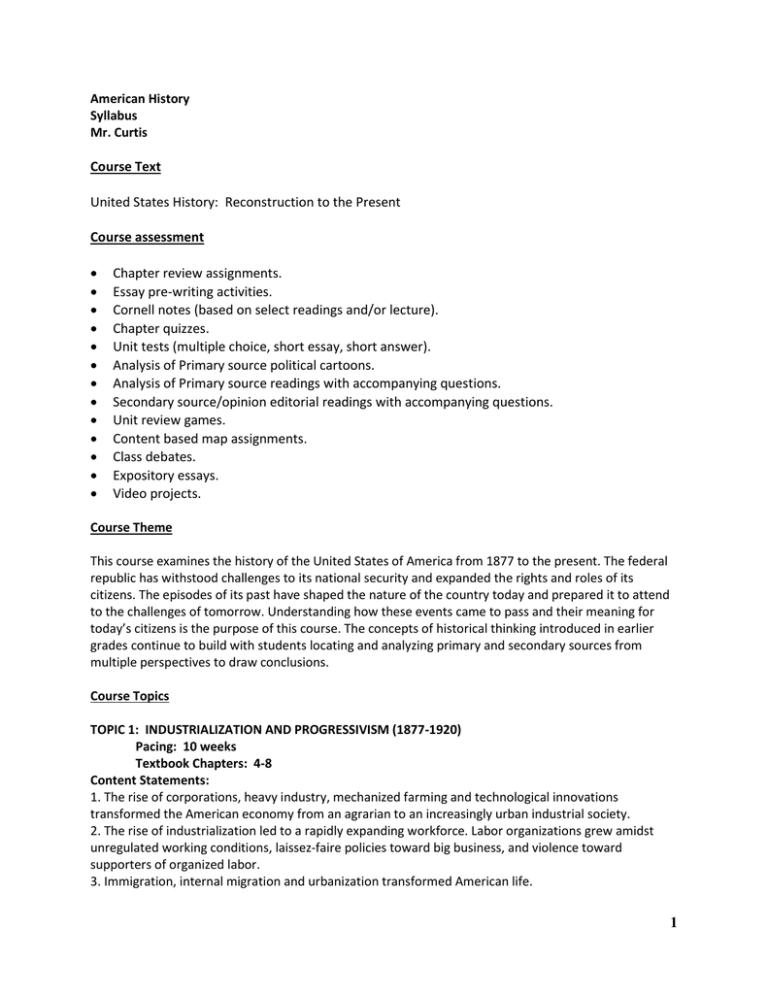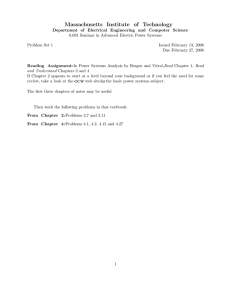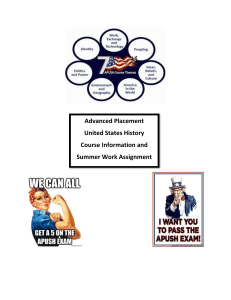Course Text Course assessment United States History: Reconstruction to the Present
advertisement

American History Syllabus Mr. Curtis Course Text United States History: Reconstruction to the Present Course assessment Chapter review assignments. Essay pre-writing activities. Cornell notes (based on select readings and/or lecture). Chapter quizzes. Unit tests (multiple choice, short essay, short answer). Analysis of Primary source political cartoons. Analysis of Primary source readings with accompanying questions. Secondary source/opinion editorial readings with accompanying questions. Unit review games. Content based map assignments. Class debates. Expository essays. Video projects. Course Theme This course examines the history of the United States of America from 1877 to the present. The federal republic has withstood challenges to its national security and expanded the rights and roles of its citizens. The episodes of its past have shaped the nature of the country today and prepared it to attend to the challenges of tomorrow. Understanding how these events came to pass and their meaning for today’s citizens is the purpose of this course. The concepts of historical thinking introduced in earlier grades continue to build with students locating and analyzing primary and secondary sources from multiple perspectives to draw conclusions. Course Topics TOPIC 1: INDUSTRIALIZATION AND PROGRESSIVISM (1877-1920) Pacing: 10 weeks Textbook Chapters: 4-8 Content Statements: 1. The rise of corporations, heavy industry, mechanized farming and technological innovations transformed the American economy from an agrarian to an increasingly urban industrial society. 2. The rise of industrialization led to a rapidly expanding workforce. Labor organizations grew amidst unregulated working conditions, laissez-faire policies toward big business, and violence toward supporters of organized labor. 3. Immigration, internal migration and urbanization transformed American life. 1 4. Following Reconstruction, old political and social structures reemerged and racial discrimination was institutionalized. 5. The Progressive era was an effort to address the ills of American society stemming from industrial capitalism, urbanization and political corruption. TOPIC 2: FOREIGN AFFAIRS FROM IMPERIALISM TO POST-WORLD WAR I (1898-1930) Pacing: 4 weeks Textbook Chapters: 9-10 Content Statements: 1. As a result of overseas expansion, the Spanish-American War and World War I, the United States emerged as a world power. 2. After WWI, the United States pursued efforts to maintain peace in the world. However, as a result of the national debate over the Versailles Treaty ratification and the League of Nations, the United States moved away from the role of world peacekeeper and limited its involvement in international affairs. TOPIC 3: PROSPERITY, DEPRESSION AND THE NEW DEAL (1919-1941) Pacing: 5 weeks Textbook Chapters: 11-13 Content Statements: 1. Racial intolerance, anti-immigrant attitudes and the Red Scare contributed to social unrest after World War I. 2. An improved standard of living for many, combined with technological innovations in communication, transportation and industry, resulted in social and cultural changes and tensions. 3. Movements such as the Harlem Renaissance, African-American migration, women’s suffrage and Prohibition all contributed to social change. 4. The Great Depression was caused, in part, by the federal government’s monetary policies, stock market speculation, and increasing consumer debt. The role of the federal government expanded as a result of the Great Depression. TOPIC 4: FROM ISOLATION TO WORLD WAR (1930-1945) Pacing: 4 weeks Textbook Chapters: 14-15 Content Statements: 1. During the 1930s, the U.S. government attempted to distance the country from earlier interventionist policies in the Western Hemisphere as well as retain an isolationist approach to events in Europe and Asia until the beginning of WWII. 2. The United States mobilization of its economic and military resources during World War II brought significant changes to American society. TOPIC 5: THE COLD WAR (1945-1991) Pacing: 6 weeks Textbook Chapters: 16, 19, 20, 23 Content Statements: 1. Use of atomic weapons changed the nature of war, altered the balance of power and began the nuclear age. 2. The United States followed a policy of containment during the Cold War in response to the spread of communism. 3. The Second Red Scare and McCarthyism reflected Cold War fears in American society. 2 4 The Cold War and conflicts in Korea and Vietnam influenced domestic and international politics. 5. The collapse of communist governments in Eastern Europe and the U.S.S.R. brought an end to the Cold War. TOPIC 6: SOCIAL TRANSFORMATIONS IN THE UNITED STATES (1945-1994) Pacing: 6 weeks Textbook Chapters: 17, 18, 21, 22, 23 Content Statements: 1. Following World War II, the United States experienced a struggle for racial and gender equality and the extension of civil rights. 2. The postwar economic boom, greatly affected by advances in science, produced epic changes in American life. 3. The continuing population flow from cities to suburbs, the internal migrations from the Rust Belt to the Sun Belt, and the increase in immigration resulting from passage of the 1965 Immigration Act have had social and political effects. 4. Political debates focused on the extent of the role of government in the economy, environmental protection, social welfare and national security. TOPIC 7: UNITED STATES AND THE POST-COLD WAR WORLD (1991 TO PRESENT) Pacing: 1 week Textbook Chapters: 24 Content Statements: 1. Improved global communications, international trade, transnational business organizations, overseas competition and the shift from manufacturing to service industries have impacted the American economy. 2. The United States faced new political, national security and economic challenges in the post-Cold War world and following the attacks on September 11, 2001. 3


